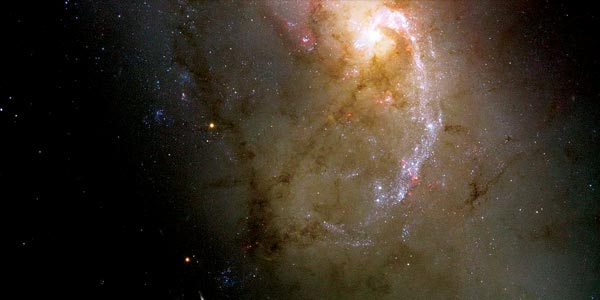Galaxy without Any Dark Matter Baffles Astronomers

Scientists were recently surprised to find galaxy NGC 1052-DF2 devoid of the mysterious substance, Dark Matter, but say its absence strengthens case for its existence, writes HANNAH DEVLIN.
A distant galaxy that appears completely devoid of dark matter has baffled astronomers and deepened the mystery of the universe’s most elusive substance.
The absence of dark matter from a small patch of sky might appear to be a non-problem, given that astronomers have never directly observed dark matter anywhere.
However, most current theories of the universe suggest that everywhere that ordinary matter is found, dark matter ought to be lurking too, making the newly observed galaxy an odd exception.
“Something like this has never been seen,” said Prof Pieter van Dokkum, of Yale University, the study’s senior author. “It challenges the standard ideas of how we think galaxies form.”
Dark matter’s existence is inferred from its gravitational influence on visible objects, which suggests it dominates over ordinary matter by a ratio of 5:1.
Some of the clearest evidence comes from tracking stars in the outer regions of galaxies, which consistently appear to be orbiting faster than their escape velocity, the threshold speed at which they ought to break free of the gravitational binds holding them in place and slingshot into space.
This suggests there is unseen, but substantial, mass holding stars in orbit.
In the Milky Way, there is about 30 times more dark matter than normal matter. The latest observations focused on an ultra-diffuse galaxy – ghostly galaxies that are large but have hardly any stars – called NGC 1052-DF2.
The team tracked the motions of ten bright star clusters and found that they were travelling way below the velocities expected.
“They basically look like they’re standing still,” said van Dokkum.
The velocities gave an upper estimate for the galactic mass of 400 times lower than expected. “If there is any dark matter at all, it’s very little,” van Dokkum explained. “The stars in the galaxy can account for all of the mass, and there doesn’t seem to be any room for dark matter.”
Paradoxically, the authors said the discovery of a galaxy without dark matter counts as evidence that it probably does exist. A competing explanation for the fast-orbiting stars is that the way gravity drops off with distance has been misunderstood – but if this were the case, all galaxies should follow the same pattern.
Andrew Pontzen, a cosmologist at University College London who was not involved in the work, said:
“Alternative gravity theories tend to be tuned to reproduce typical galaxies, which means they can struggle to account for anything new or unusual.”
The observation also raises questions about how galaxies formed in the first place. Most current narratives suggest that because dark matter dominates the universe, slightly denser patches of dark matter would have provided the initial seeds for things to clump together in the early universe and eventually end up as stars and galaxies.
“This whole story is one of dark matter being the scaffolding on which every galaxy is built,” said van Dokkum.
“It’s not just a component of a galaxy, like a spiral arm, it’s more like the fundamental skeleton that underlies all the structure in the universe.”
Prof Jeremiah Ostriker, a professor of astronomy at Columbia University in New York, described the observation as highly significant.
“The standard paradigm has gas falling into halos – or lumps – of dark matter and turning into stars to make a galaxy,” he said. “This one was clearly made some other way.”
Speculative explanations include that a collision or cataclysmic event within the galaxy resulted in all the dark matter being swept away.
Van Dokkum and colleagues identified the galaxy, NGC 1052-DF2, using a low-budget setup called the Dragonfly Telephoto Array in New Mexico, which they designed from 48 commercial cameras and paparazzi-style lenses.
The initial images just showed a ghostly blob on the night sky, but by peering more closely at it using the Gemini Multi Object Spectrograph and Keck telescopes they were able to pick out star clusters within the galaxy and track their movements.
The teams are now turning to look at other ultra-diffuse galaxies to see whether any others are similarly deficient in dark matter.
The findings are published in the journal Nature.
[Courtesy: https://www.theguardian.com/science/2018/mar/28/galaxy-without-any-dark-matter-baffles-astronomers]

